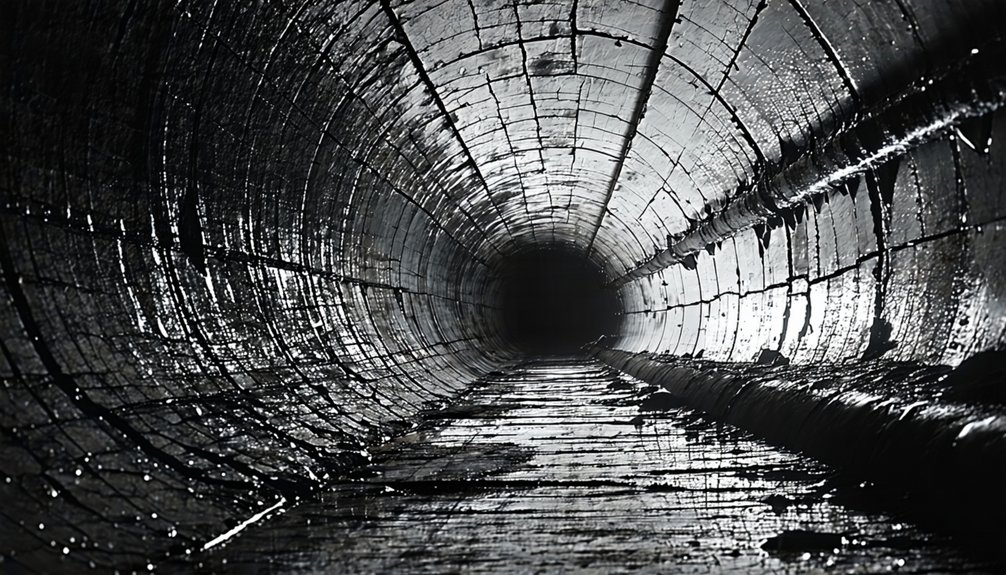Sewer line damage manifests through distinct signs. Homeowners may notice foul odors, sewage backups, slow drains, or unusual green patches in their yard. These indicators suggest potential blockages or leaks caused by tree roots, aging materials, or improper installation. Ignoring such signs can lead to serious health hazards and costly repairs. Timely intervention is essential for maintaining plumbing system integrity. Further details on causes and preventative measures can enhance understanding of sewer line issues.
Common Indicators of Sewer Line Damage
When homeowners notice unusual signs around their property, it is essential to contemplate the possibility of sewer line damage. Common indicators include foul odors resembling rotten eggs, signaling potential leaks or sewage backups that require immediate attention. Frequent sewage backup in multiple drains, especially in lower fixtures, can suggest serious issues like a clogged or collapsed main sewer line, necessitating professional inspection. Slow drains across various fixtures may reveal significant underlying problems, warranting further investigation to avert flooding. Additionally, lush, unusually green patches of grass in the yard often indicate a broken sewer line, where leaking waste acts as a fertilizer. Gurgling noises from toilets or drains typically point toward trapped air, suggesting blockages or other plumbing issues. Homeowners encountering these signs of a broken sewer line should seek professional help to address and rectify the situation effectively.
Potential Causes of Sewer Line Issues
Sewer line issues can arise from various underlying causes that compromise the integrity of the system. One significant factor is the intrusion of tree roots, which can infiltrate and crush pipes, leading to common signs of sewer line problems such as blockages and breaks. Aging pipes, especially those composed of clay or cast iron, are particularly vulnerable to corrosion and cracks over time. Moreover, improper installation practices can contribute to sewer line damage, as inadequate sloping or poor joint connections may lead to premature failure. Additionally, excessive buildup of grease, hair, and foreign objects can create clogs that exert pressure on the system, increasing the risk of a damaged sewer line. Environmental factors, including shifting soil or severe weather conditions, may also destabilize the ground around sewer lines, resulting in cracks and potential sewage leaks. Identifying these causes is essential for effective management.
Importance of Timely Sewer Line Repairs
Recognizing the importance of timely sewer line repairs is essential for maintaining a healthy and functional plumbing system. Ignoring signs of sewer line issues, such as gurgling sounds, sewer odor, and frequent sewer backups, can lead to significant structural damage, costing thousands in repairs. Promptly addressing these problems helps mitigate health hazards associated with mold and mildew, which thrive in damp environments created by untreated leaks. Furthermore, early intervention can prevent yard waste accumulation and pest infestations, preserving the overall health of the home environment. Regular inspections and timely sewer line repairs not only extend the lifespan of the plumbing system but also guarantee efficient drainage, reducing the likelihood of premature replacements. Homeowners must prioritize these repairs to safeguard their property and well-being, ultimately avoiding the detrimental consequences of neglecting sewer line maintenance.
Frequently Asked Questions
How Do You Tell if You Have a Damaged Sewer Line?
Detecting damage signs in a sewer line can feel like unearthing a mystery in a classic detective novel. Key indicators include foul odors reminiscent of rotten eggs, persistent water backup, and slow drains across multiple fixtures. Regular pipe inspections can reveal issues like root intrusion or blockages. Additionally, signs such as unusually lush patches in the yard or potential property damage underscore the importance of timely maintenance to prevent escalating plumbing issues.
Is Sewer Line Damage Covered by Homeowners Insurance?
Homeowners insurance coverage for sewer line damage varies considerably, often limited by policy exclusions. Damage assessments typically reveal that wear and tear or maintenance neglect are not covered. External factors, such as tree root intrusion, may be eligible under specific endorsements. To navigate the claim process effectively, homeowners must understand their policy limits and maintenance responsibilities. Preventive measures can mitigate repair costs, but filing claims requires careful documentation of the damage.
How Do You Fix a Damaged Sewer Line?
Addressing a damaged sewer line is akin to identifying a hidden wound; careful inspection is essential. Effective sewer repair methods include trenchless technology, which minimizes disruption, and traditional excavation for severe cases. Homeowners should utilize plumbing inspection tips to detect warning signs early. While DIY sewer fixes may seem appealing, professional services often provide cost-effective repairs and root intrusion solutions. Regular maintenance tips can further prolong the system's lifespan, ensuring peak functionality.
How Much Does It Cost to Clear a Sewer Line?
When considering sewer line clearing costs, homeowners typically encounter fees ranging from $150 to $800, influenced by blockage severity and required plumbing services. Factors such as root intrusion or accessibility may necessitate professional help, including pipe inspections or advanced drainage solutions. Basic drain cleaning averages between $200 and $500, while emergency repairs can increase costs considerably. Regular preventative maintenance may reduce the need for these services, ultimately saving homeowners money in the long run.



